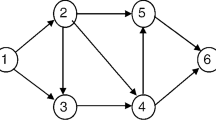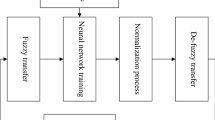Abstract
A fuzzy neural network model based on the shortest path parallel algorithm (FNNMSPPA) is proposed. With this model, the shortest path parallel programming on the basis of 0–1 coding can be realized. Moreover, in the method proposed in this paper, the individual passive fuzzy neural network is transformed into a model construction. At this time, the interaction between the system and the surrounding environment is carried out by using the fuzzy neural network. Therefore, it has better adaptability to the neural network environment. It can detect the changes in the environment in time, and can effectively track the shortest path using pole values in the space. And in this paper, the performance of this algorithm is verified by dynamic simulation experiment. The results of the study show that the algorithm designed in this paper can still guarantee the realization of stable model construction for the environment with more severe environmental changes, that is, the robustness of the algorithm is strong. And compared with the same method, this method has stronger dynamic search ability, and the extreme point tracking ability is also superior.

Similar content being viewed by others
Change history
05 December 2022
This article has been retracted. Please see the Retraction Notice for more detail: https://doi.org/10.1007/s10586-022-03909-4
References
Mansoori, A., Effati, S., Eshaghnezhad, M.: An efficient recurrent neural network model for solving fuzzy non-linear programming problems. Appl. Intell. 46(2), 1–20 (2016)
Moghtadaei, M., Golpayegani, M.R.H., Malekzadeh, R.: A variable structure fuzzy neural network model of squamous dysplasia and esophageal squamous cell carcinoma, based on a global chaotic optimization algorithm. J. Theor. Biol. 318(2), 164–172 (2013)
Lin, F.J., Sun, I.F., Yang, K.J., Chang, J.K.: Recurrent fuzzy neural cerebellar model articulation network fault-tolerant control of six-phase permanent magnet synchronous motor position servo drive. IEEE Trans. Fuzzy Syst. 24(1), 153–167 (2016)
Khademi, M.: A new variable bit rate (vbr) video traffic model based on fuzzy system implemental using generalized regression neural network (grnn). Theoret. Comput. Sci. 412(16), 1484–1491 (2011)
Wang, N., Er, M.J., Han, M.: Large tanker motion model identification using generalized ellipsoidal basis function-based fuzzy neural networks. IEEE Trans. Cybern. 45(12), 2732–2743 (2015)
Lohani, A.K., Kumar, R., Singh, R.D.: Hydrological time series modeling: a comparison between adaptive neuro-fuzzy, neural network and autoregressive techniques. J. Hydrol. 442–443, 23–35 (2012)
Abdollahzade, M., Miranian, A., Hassani, H., Iranmanesh, H.: A new hybrid enhanced local linear neuro-fuzzy model based on the optimized singular spectrum analysis and its application for nonlinear and chaotic time series forecasting. Inf. Sci. 295, 107–125 (2015)
Vafakhah, M.: Application of artificial neural networks and adaptive neuro-fuzzy inference system models to short-term streamflow forecasting. Can. J. Civ. Eng. 39(4), 402–414 (2012)
Ahn, J., Cho, S., Chung, D.H., Yan, J.: Analysis of energy and control efficiencies of fuzzy logic and artificial neural network technologies in the heating energy supply system responding to the changes of user demands. Appl. Energy 190, 222–231 (2017)
Li, Mengshan, Huang, Xingyuan, Liu, Hesheng, Liu, Bingxiang, Yan, Wu, Deng, Xiaozhen: Solubility prediction of gases in polymers using fuzzy neural network based on particle swarm optimization algorithm and clustering method. J. Appl. Polym. Sci. 129(6), 3297–3303 (2013)
Author information
Authors and Affiliations
Corresponding author
Additional information
This article has been retracted. Please see the retraction notice for more detail: https://doi.org/10.1007/s10586-022-03909-4
Rights and permissions
Springer Nature or its licensor (e.g. a society or other partner) holds exclusive rights to this article under a publishing agreement with the author(s) or other rightsholder(s); author self-archiving of the accepted manuscript version of this article is solely governed by the terms of such publishing agreement and applicable law.
About this article
Cite this article
Wang, J., Zhong, T. & Zhou, H. RETRACTED ARTICLE: Fuzzy neural network model construction based on shortest path parallel algorithm. Cluster Comput 22 (Suppl 2), 3413–3418 (2019). https://doi.org/10.1007/s10586-018-2188-x
Received:
Revised:
Accepted:
Published:
Issue Date:
DOI: https://doi.org/10.1007/s10586-018-2188-x




